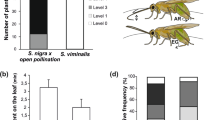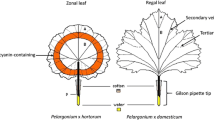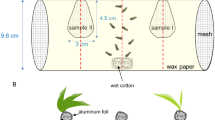Abstract
The ovipositional stimulation for the shoot galling sawfly, Euura lasiolepis, whose natural host is the North American willow, Salix lasiolepis, was studied in response to its original host, Finnish willows, poplar species, and individual phenolic glucosides and fractions. The major phenolic glucosides in the natural host were salicortin and tremulacin, which were also the major components in the Finnish S. purpurea and S. rosmarinifolia. The natural host, S. lasiolepis, was chosen over six Finnish willow species in multiple-choice tests. Multiple-choice tests with six Finnish willow species and one Finnish popular species showed that S. rosmarinifolia was significantly more attractive than any of the other species by at least 16-fold. No-choice testing with phenolic glucosides showed the tremulacin fraction to be the significant ovipositional stimulant, which elicited probes with the ovipositor at least 19 times more frequently than other glucosides. A tremulacin fraction at 1.5% elicited significantly more probes than a tremulacin fraction tested at 0.4%. In addition, tremulacin was the only glucoside to induce prolonged and repeated probing with the ovipositor, lasting a mean of 6.4 sec per bout per female. Only single probes lasting a fraction of a second were observed in response to other glucosides. This is the second study showing a direct effect of a phenolic glucoside as an ovipositional stimulant for a sawfly, and it also suggests the existence of a mechanism that enables females to respond positively in a graded way to shoot length heterogeneity in host plants and populations.
Similar content being viewed by others
REFERENCES
Boecklen, W. J., Price, P. W., and Mopper, S. 1990. Sex and drugs and herbivores: Sex biased herbivory in arroyo willow (Salix lasiolepis). Ecology 71:581–588.
BoevÉ, J.-L., and Pasteels, J. M. 1985. Modes of defense in nematine sawfly larvae: Efficiency against ants and birds. J. Chem. Ecol. 11:1019–1036.
BoevÉ, J.-L., Braekman, J. C., Daloze, D., Houart, M., and Pasteels, J. M. 1984. Defensive secretions of Nematinae larvae (Symphyta-Tenthredinidae). Experientia 40:546–547.
Codella, S. G., and Raffa, K. F. 1993. Defense strategies of folivorous sawflies, pp. 261–294, in M. R. Wagner and K. F. Raffa (eds.). Sawfly Life History Adaptations to Woody Plants. Academic Press, San Diego.
Craig, T. P., Price, P. W., Clancy, K. M., Waring, G. M., and Sacchi, C. F. 1988. Forces preventing coevolution in the three-trophic-level system: Willow, a gall-forming herbivore, and parasitoid, pp. 57–80, in K. Spencer (ed.). Chemical Mediation of Coevolution. Academic Press, New York.
Craig, T. P., Itami, J. K., and Price, P. W. 1989. A strong relationship between oviposition preference and larval performance in a shoot-galling sawfly. Ecology 70:1691–1699.
Eisner, T. 1970. Chemical defense against predation in arthropods, pp. 157–217, in E. Sondheimer and J. B. Simeone (eds.). Chemical Ecology. Academic Press, New York.
Eisner, T. 1994. Integumental slime and wax secretion: Defensive adaptations of sawfly larvae. J. Chem. Ecol. 20:2743–2749.
Julkunen-Tiitto, R. 1985. Phenolic constituents in the leaves of northern willows: Methods for the analysis of certain phenolics. J. Agric. Food Chem. 33:213–217.
Julkunen-Tiitto, R. 1986. A chemotaxonomic survey of phenolics in leaves of northern Salicaceae species. Phytochemistry 25:663–667.
Julkunen-Tiitto, R. 1989. Distribution of certain phenolics in Salix species (Salicaceae). PhD thesis. University of Joensuu, Joensuu.
Julkunen-Tiitto, R., Rousi, M., Bryant, J. P., Sorsa, S., KeinÄnen, M., and Sikanen, H. 1996. Chemical diversity of several Betulaceae species: comparison of phenolics and terpenoids in northern birch stems. Tree 11:16–22.
Kearsley, M. J. C., and Whitham, T. G. 1993. Guns and butter. A no cost defense against predation for Chrysomela confluens. Oecologia 92:556–562.
Kolehmainen, J., Roininen, H., Julkunen-Tiitto, R., and Tahvanainen, J. 1994. Importance of phenolic glucosides in host selection of shoot galling sawfly, Euura amerinae, on Salix pentandra. J. Chem. Ecol. 20:2455–2466.
Kolehmainen, J., Julkunen-Tiitto, R., Roininen, H., and Tahvanainen, J. 1995. Phenolic glucosides as feeding cues for willow-feeding leaf beetles. Entomol. Exp. Appl. 74:235–243.
Lindroth, R. L., Scriber, J. M., and Hsia, M. T. S. 1988. Chemical ecology of tiger swallowtail: Mediation of host use by phenolic glucosides. Ecology 69:814–822.
Meier, B., Julkunen-Tiitto, R., Tahvanainen, J., and Sticher, O. 1988. Comparative high-performance liquid and gas-liquid chromatographic determination of phenolic glucosides in Salicaceae species. J. Chromatogr. 442:175–186.
Pasteels, J. M., Braekman, J.-C., and Daloze, D. 1988. Chemical defense in the Chrysomelidae, pp. 233–252, in P. Jolivet, E. Petitpierre and T. H. Hsiao (eds.). Biology of Chrysomelidae. Kluwer Academic, Dordrecht, The Netherlands.
Price, P. W., and Roininen, H. 1993. The adaptive radiation in gall induction, pp. 229–257, in M. R. Wagner and K. F. Raffa (eds.). Sawfly Life History Adaptations to Woody Plants. Academic Press, Orlando.
Price, P. W., Waring, G. L., Julkunen-Tiitto, R., Tahvanainen, J., Mooney, H. A., and Craig, T. P. 1989. The carbon-nutrient balance hypothesis in within-species phytochemical variation of Salix lasiolepis. J. Chem. Ecol. 15:1117–1131.
Price, P. W., Craig, T. P., and Roininen, H. 1995. Working toward theory on galling sawfly population dynamics, pp. 321–338, in N. Cappuccino and P. W. Price (eds.). Population Dynamics: New Approaches and Synthesis. Academic Press, San Diego.
Rank, N. E. 1992. Host plant preference based on salicylate chemistry in a willow leaf beetle (Chrysomela aeneicollis). Oecologia 90:95–101.
Roininen, H., and Tahvanainen, J. 1989. Host selection and larval performance of two willow-feeding sawflies. Ecology 70:129–136.
Roininen, H., Price, P. W., and Tahvanainen, J. 1993a. Colonization and extinction in a population of the shoot-galling sawfly, Euura amerinae. Oikos 68:448–454.
Roininen, H., Vuorinen, J., Tahvanainen, J., and Julkunen-Tiitto, R. 1993b. Host preference and allozyme differentiation in shoot galling sawfly, Euura atra. Evolution 47:300–308.
Roininen, H., Price, P. W., and Tahvanainen, J. 1995. Bottom-up and top-down influences in the trophic system of a willow, a galling sawfly, parasitoids and inquilines. Oikos 77:44–50.
Rowell-Rahier, M. 1984. The food plant preferences of Phratora vitellinae (Coleoptera: Chrysomelidae). Oecologia 64:369–374.
Siegel, S. 1956. Nonparametric Statistics for the Behavioral Sciences. McGraw-Hill, New York.
Smiley, J. T., Horn, J. H., and Rank, N. E. 1985. Ecological effects of salicin at three trophic levels: New problems from old adaptations. Science 229:649–651.
Soetens, P., and Pasteels, J. M. 1994. Synergistic effect of secondary compounds and nutrients in the host plant choice of a salicaceous-feeding leaf beetle: Phratora vitellinae (Coleoptera: Chrysomelidae). Med Fac. Landbouww. Univ. Gent 59(2b):685–689.
Tahvanainen, J., Helle, H., Julkunen-Tiitto, R., and Lavola, A. 1985a. Phenolic compounds of willow bark as deterrents against feeding by mountain hare. Oecologia 65:319–323.
Tahvanainen, J., Julkunen-Tiitto, R., and Kettunen, J. 1985b. Phenolic glucosides govern the food selection pattern of willow feeding leaf beetles. Oecologia 67:52–56.
Waring, G. L., and Price, P. W. 1988. Consequences of host plant chemical and physical variability to an associated herbivore. Ecol. Res. 3:205–216.
Author information
Authors and Affiliations
Rights and permissions
About this article
Cite this article
Roininen, H., Price, P.W., Julkunen-Tiitto, R. et al. Oviposition Stimulant for a Gall-Inducing Sawfly, Euura lasiolepis, on Willow is a Phenolic Glucoside. J Chem Ecol 25, 943–953 (1999). https://doi.org/10.1023/A:1020813305196
Issue Date:
DOI: https://doi.org/10.1023/A:1020813305196




